
| HOME | WRITING SAMPLES | WRITING FOR YOU | RECENT PUBLICATIONS | WORKS IN PROGRESS | COMPANY HISTORY |

White Jade Design Int'l
Welcome to Asian-American Weddings FAQ:
A Ceremony Plan for a Modern Asian-American Wedding
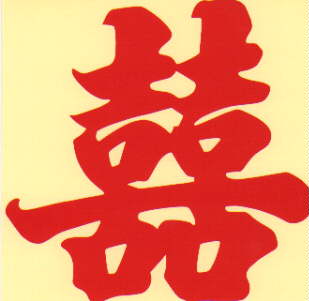
written in 1998 with updates in 2004
Introduction
Your Wedding...it is a very special day filled with rituals and traditions. While there are dozens and dozens of wedding planners for most kinds of weddings, the subject of the Chinese or Asian wedding is rarely touched upon. The one VERY GOOD guide to Asian-American weddings we found, entitled, "Wild Geese and Tea, An Asian-American Wedding Planner" (Shu-Shu Costa, available at Amazon.com) gives some nice ideas, presents what the original traditions are, yet fails to present an example of an actual wedding service. Another resource for the net-savvy couple is a great website we found on Chinese weddings that gives the old customs and the current Xiang Gang (Hong Kong) customs used in the 1990s. We hope you'll read this FAQ first before jumping off to that page though.
In the quest to create a wedding service she might someday be able to use herself, designer Laurel A. Rockefeller succeeded in creating a real, usable Chinese-American service. Presented here, it is an example to use in creating your own ideas for your own wedding--or to use outright and in nearly every detail. The details are mandatorily flexible. Everyone's locations and preferences are different. No two weddings, if done correctly, are ever exactly the same and in fact they should not be.

What we hope to do here is to synthesize a wedding service for New China and 21st century Asian, one drawing upon both the western and Asian cultures. With the trend of the 1990s to be in having both traditional ceremonies and/or receptions AND western ones, this style presented here hopes to lesson the extra expenses involved.
This service also reflects the particular interests and preferences of our designer, a woman who enjoys dancing at parties and spirituality in religious locations--the sacred and the secular in their own times and places. If anything here isn't your style, change it. This is just a sample to get you thinking. If you would like to discuss your own situation and needs with us directly, our email is open to you. Thank you.
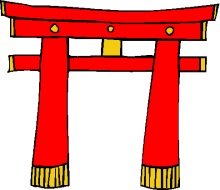
Site preparations:
Indoor location such as a Church, Temple, or other Auditorium. Chairs should be arranged in rows or pews. This is the traditional western ceremony configuration most people are familiar with. Adapt as needed to your chosen ceremony site.
Decorations: red and gold are the traditional Chinese wedding colors. Add these to your standard western wedding colors. Here in our example we'll use purple/lavender and blue with occasional white accent.

This Shuang xi is the Chinese wedding symbol
For a real Chinese touch and if you can locate them, decorate in shuang xi (double happiness), phoenix, and dragons. Paper lanterns, if allowed, or covers for lamps also help set a more Chinese touch. Be creative in integrating Asian or Chinese items into the scene, depending on how western or Asian you want the ceremony to look. Of course traditional red banners with characters dyed/embroidered/painted on always look great so don't forget those if the walls need something. Another idea if the walls really need some help is to place wicker screens across sections of the wall or to use as a divider if the location doesn't have a foyer. Add fresh or silk flowers to these screens and suddenly the not so attractive walls look elegant.
For a more American touch with a hint of Chinese, try adding red and gold accents to more Western decoration forms. A touch of red or gold ribbon on the western wedding colored decorations can go a long way. Choose brass candelabras with red ribbons or bows.
Two altars are needed, both movable or have a table in center on which things can be moved to. They should be from 2-8 feet apart, depending on your space and may or may not include a kneeling bench. These are the altars to the Ancestors. One is set up in honor to the Bride and her family. The second is set up to the Groom and his family. These altars are an important part of most Asian wedding traditions, but we'll use them in a more modern way for this ceremony.
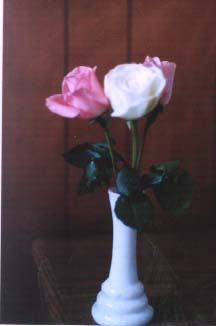
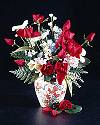
Critical to these altars is the placement of a loosely tied bouquet of flowers symbolic of the Ancestors, the Bride or Groom, and her or his more immediate family. The flowers will be joined at the end of the ceremony, so it should be arranged in something loose, yet easily movable by each person to the joined altar (actually picking up the two altars and putting them together) or unity altar (a separate, central table at the center of the ceremony area). The flowers are the central embodiment here so anything else you place on it (paper ritual money, foods, etc) is strictly optional.
Rehearsal will greatly help with the ritual of blending the altars. Make sure you know how to do this before the ceremony begins. Unlike the Western unity candle ritual, this one can be harder to actually do without a little practice.
Clothing:
The clothing we most associate with China belongs to the Jurchens/Manchus in their Qing dynasty form. The most formal of Qing dynasty clothing is called the "chaofu." The Qing dynasty form is completely brocaded in about 5 different brocade forms, including the dragon brocades. A pi-ling collar is worn as well. The groom should wear either the traditional blue surcoat, a period Chinese man's style (such the jifu), or at least a brocaded tuxedo vest in red and gold dragon brocade. A Han jifu is similar to the Chaofu, but intended for a nobleman. The jifu is brocaded until about 3 inches beyond the elbow in the sleeve where it becomes a long but solid sleeve/cuff combination. In China, the bride wears a one piece gown (such as a qi pau) unless she is from Southern China. The Costa book contains all those details.
White Jade's Dong He Xi styles also work very well as options, for both sides and for anyone in the party. These are mostly Chinese-American styles, so they work very elegantly if strictly traditional is NOT your style.
Attendants should wear either an Asian-American style in the bride's preferred wedding color (either red or one of the western colors) or an all out Western attendant gown. Groomsmen and other male attendants should wear either traditional styles or a tuxedo with a vest. Black tux looks best with most wedding colors, especially red and gold. To go the traditional or period route, women should wear a qi pau, which features an overlap and fastens at the side, and men should wear its counterpart, the da gua, which is center-closed.
Flowers:
Budgets vary, but minimum you will need will be the walking flowers: bridal and bridesmaid bouquets, boutonnieres for groom and male attendants, plus corsages, boutonnieres, etc for the honored family members and anyone else in the wedding party. Something for each of your volunteer helpers (such as guest book, gift table attendants and volunteer musicians) is a polite gesture of thanks.
You also need the bouquets for the altars. This is envisioned as about a dozen roses, lilies, or other symbolic flowers. It is not intended to be a major expense, but enough to be a presence. The more other things you put on the altars the more flowers you really need. That said, the simplest altars should have a red table clothe upon which the flowers are placed, tied with either a red, gold, or white ribbon. These flowers must be of personal and sentimental value to each side. For instance, in Ms. Rockefeller's family, yellow roses (a Celtic memorial flower) would be used. White peonies or mums are also traditional for Chinese. And if it's not clear, only FRESH FLOWERS will do for the altars, though silk flowers is fine for everything else. Other items for altar would include fruit, a glass of wine, and an empty or filled rice bowl with chopsticks on top.
Use the rice bowl and chopsticks if a near relative has died within the past several years to represent the recently departed. In such a case, prayers might be offered at the altar the day before the wedding to avoid emotional breakdown early in the wedding. It is far better to take care of this heart felt prayer and the emotions attached in advance than to ignore the often raw grief from such a loss.
Also, make it a sacred ritual before the service to actually tie the ribbons around the flowers. Though Western weddings are busy right before, the Asian-American wedding should be preceded with a meditation period during which the bride and groom tie the ribbons and place them on the altars. A nice idea for this is to perform this ritual about half to one hour before the ceremony and do the tying in the ceremony hall itself. It's a ritual that should be attended mostly by family and the attendants, though the choice is yours of course.
Photography:
Do formals at least 2 hours in advance of the prelude. Formals are time consuming events. White Jade experience shows that if you want to start on time, give your photography a day or so advance shots. If possible, even 2 weeks to 1 month ahead is prudent planning for the formals and it allows you to do a "dry run" with your stylist, florist, and makeup in advance of the wedding, giving you time to make changes. Always do your formals prior to the ceremony. Candids are, naturally, done as the event happens, and are a different matter logistically. One advantage to doing your formals days or weeks in advance is that you can have photos done in ALL your attire. Since Asian brides wear at least 2 sets of clothing, this makes it easier to switch back and forth and get everything just right. It's an important tip to follow.
Do family portraits right before the ceremony. Since family arrive usually only a day or two before, right before the ceremony is the best time to do those. Avoid doing pictures between ceremony and reception.
Prelude & Ceremony:
Prelude Music:
Organ, instrumentals, or pre-recorded music--anything is fine so long as these are pieces that are meaningful to you. If a certain song, wedding or otherwise, really stands out in your hearts, have it played at some point. Don't be afraid to mix formats. There's no reason you cannot have a string quartet play live then put on the sound system a favorite song from a CD. This is a MODERN wedding. If what you like isn't doable in person, go ahead and use pre-recorded. Some musicians are either impossible to hire or too expensive to hire in your given location. Don't be shy about how you mix these and use the pieces you want.
Prelude should last about 20 to 40 minutes in advance, depending on time of day and when guests start to arrive. Place your most treasured pieces towards the end. Also, although people always think of all ceremony music being necessarily live, it really does not need to be. All pre-recorded, all live, and a mix of the two are all acceptable options. The point is to include music that you want.
Seat close family such as parents and siblings as the final action before the processional. Separate musical piece may or may not be used.
Attendant Processional: Groomsmen escort Bridesmaids to their own song. Groom and Officiant walk up aisle in sequence they decide on.
Bride's Processional: song should be symbolic of her as an individual or something important to her. Bride walks escorted or not in her preferred style. If desired she may be carried in a sedan chair to the Altar. One optional Chinese tradition the bride might choose during the ceremony is to drop a fan just before she arrives at the altar, a traditional symbol that she belongs to her husband's (and hers) new family.
Officiant signals to audience to be seated.
Officiant introduction and comments.

At this point, while the officiant explains the symbolism of the altars to the ancestors, the bride and groom each go to her or his individual family altars and bows/kowtows a number of times--both the same number of times. If desired an actual sacrifice might be made at this point. An apple or other food item is traditional.
When the honoring of the ancestors is completed, the bride and groom each rise and meet each other at the main altar. At this point if the bride desires a "giving away" ceremony by her parents, it is done here. Or the groom may get on one knee and formally ask if the bride will marry him of her own accord--since in previous generations neither bride nor groom had any say in the matter. If bride accepts the proposal, she answers simply "dui" which means "yes" and tells him to get up or "qi lai". This signals her consent to marry and stand as equals. Bride and groom join hands, facing each other and/or the officiant.
At this point the officiant conducts wherever sermon is desired. This can be a simple lecture about love and marriage or a full scale religious sermon, depending on the couple's own Faith(s) and beliefs. Music can be inserted, poems spoken, hymns/liturgy performed, all according to the couple's interests.
Ring ceremony and vows are done per western tradition. Chinese weddings do not have a set vow script. Therefore, the more original and personal, the more Chinese and more authentic.
Optional: Following the vows is a good time to have the bride and/or groom do a special song, poem, or other personal expression of affection.
Unity candle ceremony in the western tradition. While white is the tradition for the unity candles, a Chinese-American couple should use red as the center candle since white symbolizes death. The more Chinese the ceremony is, the more important this is. Otherwise, if the ceremony look and feel is more western, by all means use the white ones. For variety and interest, consider using tapers in the favorite colors of the bride/groom. So if lavender and blue are the colors, use those, the bride lighting her colored candle and the groom with his.
Unified Honoring of the Ancestors.
At this point the two altars and their flowers are joined together in a uniquely Asian expression of the union. Turning from the tradition of the bride becoming of her husband's family, these joined altars represent that a unique union of "us" is created. The bride and groom have not left any family, but made a new one. In the simplest form, the bride carries her ancestral bouquet and the groom carries his to the central altar. If possible the separated altars are actually picked up entirely and placed together. The bride and groom merge the two ancestral bouquets, forming ONE bouquet as the ancestors of each become one.
Now the bride and groom kneel together as the officiant explains and upon cue from the officiant, both kowtow together a number of times. 3, 7, and 9 are powerful numbers so one of those is suggested.
If desired, the immediate family members from each side at this point rise and take turns, one from each side bowing together, and this ritual is repeated. Adding the family to this unity symbol enhances the sense that this marriage is about EVERYONE in the family, not just the couple and creates a more Chinese/Asian impact.
Now at this point the couple rises, hand in hand, and the officiant introduces them as wife and husband.
Recessional. Tradition says to use firecrackers to scare away evil spirits. Since this is not usually legal to do, try a pre recorded tape of firecrackers, fire works going off. You can also use whatever meshes with the rest of your choices.
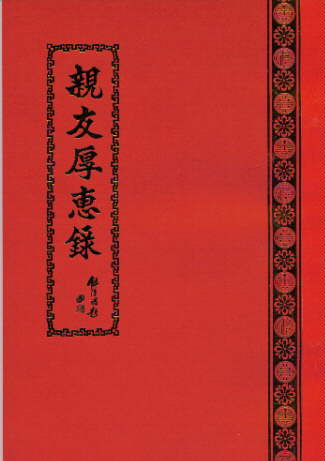

Reception:
Sometimes the reception is the hardest part of the wedding process for couples. Chinese traditional receptions usually involve large, expensive banquets--the bigger, the better.
A modern adaptation for Asian couples is to do the traditional "reception" as the rehearsal dinner at a favored Chinese restaurant or, if no authentic ones are available, a sort of pot luck or home cooked dinner for the bride, groom, and combined families. That said, except for the smallest weddings of 30 or fewer guests, the traditional reception is really a pre-wedding feast for the nearest and dearest family and friends.
This reception plan is for one held right after the wedding ceremony. Site is likely to be a fellowship hall of a church or a hotel ballroom. Dancing is a critical element of Asian tradition that should be included somehow. Consulting with your DJ in advance to make sure Asian music is included is very important. Give him a list of your favorite artists and be prepared, if need be, to make copies of your favorite songs or loan him favored CDs you absolutely want played. A well planned play list is important in ANY wedding reception, but it becomes more important in an Asian-American style wedding/reception.
If you are having a tea ceremony, time it carefully, balancing events out with the time you planned for your ceremony and reception. If the ceremony is an evening one, place the tea ceremony in the afternoon. If it's an afternoon ceremony, do it either in the morning or just a few minutes before the ceremony. You may also choose to have the tea ceremony during the reception, just as a cake cutting ceremony is done.
Note: The traditional timing for the tea ceremony is between the ceremony and reception. If you wish to do it this way, take a good look at your wedding day schedule and see if you can sneak it in. In weddings where the reception is held at the same location as the ceremony, this ceremony can easily be slipped in after the receiving line and while the guests are enjoying their drinks/or d'ouevres, especially if the number of family elders being served is only the parents. If grandparents are also in attendance, they must also be ritually served. Allow 2-5 minutes per person served and time accordingly.
One nice way to simplify the tea ceremony is to serve tea only to the parents and grandparents of the couple. Instead of just to the groom's side, honor the bride's as well. The tea ceremony is best done in more Asian attire, not a white western gown. Also modernize it by doing it as a COUPLE--not just the bride. By offering to both as a couple, you affirm you are one together.
Reception format:
Many formats are acceptable, but odds are this one will be more American than your ceremony was. Still there are many ways to integrate traditions. Serve Asian foods or both Asian and American foods. You'll definitely want to do cake (white is most traditional), but add some Asian touches. Some red roses, Chinese characters or ornaments, and other decorations are nice touches. Add some red and gold to your otherwise western decorations and color schemes. That touch of gold on your blue or purple can be the elegance you are looking for.
It is extremely traditional for the Asian bride to wear a different gown for the reception. If you marry in traditional garb, this is the time to put on the western attire and get ready to dance.
Dancing is a critical aspect of the reception. Not only is it fun, but it's one of the most traditional parts of any Chinese or Asian celebration. Use a mix of Chinese music (popular and traditional) along with American music that you usually hear at wedding receptions.
AVOID DOLLAR DANCES AND CASH BARS--these are tacky practices that nearly all wedding consultants advise against. It's also, strictly speaking, an Eastern European tradition that stands in the place of all other wedding gifts. E.g., in Polish, Czech, and other Eastern European cultures, instead of giving regular wedding gifts, the gift is given in the form of paying the bride and groom to dance with them. Since most other cultures have a tradition of wedding gifts, the dollar dance becomes a requisition for gifts above and beyond what has already been given. In conventional wisdom terms, the dollar dance is tacky because it's a means of begging for money from the guests--it's in the same category as registry cards with the invites.
Likewise cash bars are considered inappropriate. Cash bars require the guests to pay for alcohol. The guests cease to be guests and become paid customers. Especially in Asian cultures where courtesy is emphasized, it is mandatory that the couple project a strong sense of "ke qi" politeness to the guests, to make them feel like guests and not sources of revenue. So while a cash bar is generally a faux pas for weddings, in Asian weddings, it is much more so. Instead, to limit alcohol costs, either restrict alcohol to the wedding party or limit the choices. I attended a wedding in May, 2002, in Manhattan where the couple served white wine and red wine. Keeping it simple, it worked amazingly well and everyone had a great time. This is a classic example of how to serve alcohol without breaking the bank.
For the original Chinese customs, consult these websites:
http://24.1.238.207/jelly/wedcus.html
http://www.chcp.org/Vwedding.html

| HOME | WRITING SAMPLES | WRITING FOR YOU | RECENT PUBLICATIONS | WORKS IN PROGRESS | COMPANY HISTORY |